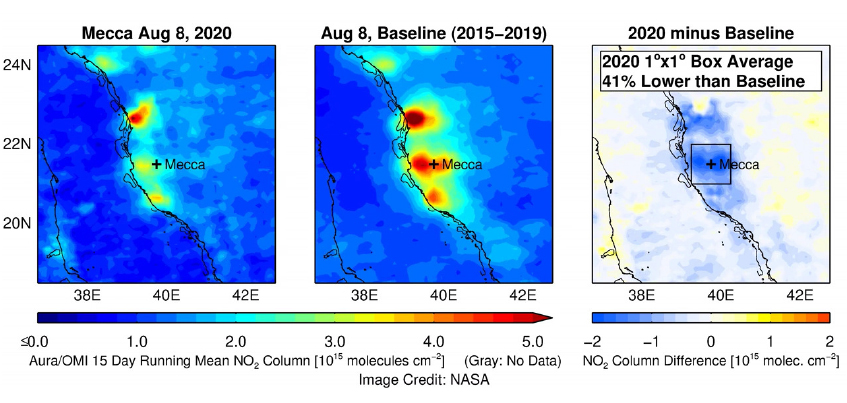NO2 measurements from the Aura Ozone Monitoring Instrument (OMI) show below normal NO2 during August 2020 in the Middle East (blue colors in image at right), particularly for the cities of Riyadh and Mecca. Typically between July and September, millions of people make the annual pilgrimage to Mecca, but this year the pilgrimage was limited to only 10,000 people in response to the COVID-19 pandemic.
Due to the reduced travel in Saudi Arabia, tropospheric NO2 measured by OMI was as much as 50% lower than normal (i.e., 5-y average) for Riyadh and Mecca (image lower right) during this period.

The images are from the OMI Global Nitrogen Dioxide Monitoring website
Data from the Aura Ozone Monitoring Instrument (OMI) are facilitating scientific research on the impact of the COVID-19 pandemic on global air quality. The OMI Team has identified numerous peer-reviewed manuscripts already published in the scientific literature since the start of the pandemic. Undoubtedly, there will be many more publications using OMI data of two major air pollutants:
Nitrogen dioxide (NO2) is primarily emitted from burning fossil fuels (diesel, gasoline, coal). If processed and interpreted carefully, NO2 levels observed from space serve as an effective proxy for NO2 levels at Earth's surface.
Sulfur dioxide (SO2) is emitted from anthropogenic activities that include electricity generation, oil and gas extraction, and metal smelting. SO2 is emitted during electricity generation if the coal burned has sulfur impurities that are not removed (or not “scrubbed”) from the plant’s exhaust stacks
Air Quality: While air pollution is decreasing around the world due to lockdown orders, the US government has relaxed pollution emission restrictions on some industrial sectors (e.g., power plants). Therefore, the changes in air pollution associated with the pandemic will serve as a natural experiment in how the atmosphere responds to changes in pollutant emissions from various sources.
Climate: Several recent studies by the proposers have shown that NO2 emissions inferred from satellite data serve as an effective proxy for co-emitted CO2 emissions from cities and power plants. Therefore, researchers may be able to assess the impact of the pandemic on climate gas emissions.
Economics: Given that most world economies are driven by fossil fuels, economists may use NO2 data, a non-traditional source of data for this community, to assess the impact of the pandemic on economic activity around the world, including in countries without reliable economic data.
Intelligence Agencies: The global intelligence community will likely find interesting uses of the NO2 data for assessing the impact of the pandemic on world countries, including with world governments that purposely misrepresent or withhold the true extent of the pandemic’s impact.
Health Professionals: The NO2 data may be used to gauge the effectiveness (e.g., reduction in emissions from traffic and industry) of lockdown efforts to contain or slow the pandemic in a given area.
Data Sources: Satellite NO2 measurements from the Aura Ozone Monitoring Instrument (OMI). OMI is a Dutch-Finnish contribution to the NASA Aura mission.
References: Zach Fasnacht (SSAI), Joanna Joiner (NASA) + GSFC Aura Ozone Monitoring Instrument (OMI) Team
11.2020